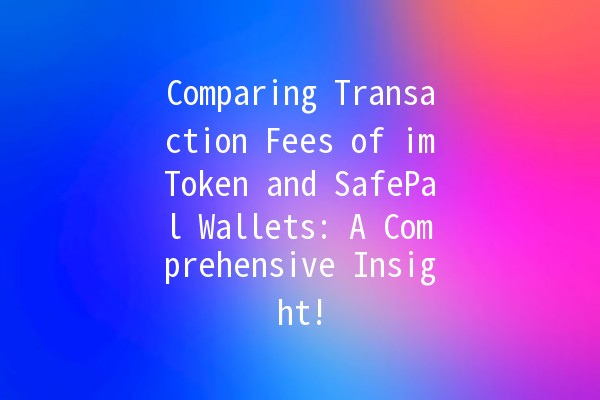In the world of cryptocurrency, choosing a suitable wallet is crucial, not only for the security of your assets but also for managing transaction costs effectively. This article dives deep into comparing the transaction fees of two popular digital wallets: imToken and SafePal. By understanding how these wallets function in terms of fees, readers can make informed decisions that align with their financial strategies.

Every time you make a transaction – whether it's sending or receiving cryptocurrencies – you’ll likely incur a fee. These transaction fees can vary significantly between different wallets and platforms. Understanding what influences these fees can help users save money and optimize their account management.
imToken is a widely used multicurrency wallet that supports Ethereum and various ERC20 tokens. The wallet focuses on user experience while providing robust security features.
Ethereum Network Fees: imToken charges transaction fees mainly based on Ethereum's gas price. Users can set their preferred gas price, which affects transaction speed and fee amount.
Token Swaps: Through the imToken DApp, users can swap tokens directly in the wallet. The platform typically charges a small fee for this service, which varies based on the tokens being swapped.
Example: If you notice lower fees during weekends or late night hours, plan your transactions accordingly.
Example: If you're not in a rush, set the gas price slightly below the recommended limit to save costs.
Example: Instead of making three separate transfers, combine them into one.
SafePal is another popular wallet that supports various cryptocurrencies and aims to provide a secure and userfriendly environment. Being a hardware wallet option also offers an additional layer of security for users.
Transaction Fees: SafePal calculates fees based on the underlying blockchain. Similar to imToken, users are subject to the network's gas prices.
Token Swaps and Transfers: SafePal offers swapping features within the app, and the fees are generally competitive, focusing on transparency with minimal hidden costs.
Example: Using Ethereum Gas Station to forecast and act when prices drop can save significant amounts in fees.
Example: Observing fees during times when the market is less active can help hone in on the best transaction moments.
Example: If you can wait for a crucial transaction, use a slower transfer speed to benefit from reduced fees.
| Criteria | imToken | SafePal |
||||
| Fee Structure | Gас prices + swaps | Networkbased fees + swaps |
| User Experience | High, userfriendly interface | Secure hardware + easy navigation |
| Customization | Gas price settings available | Speed settings for transactions |
Both imToken and SafePal present valuable features, especially in terms of managing transaction fees. The best choice often depends on individual preferences, the specific cryptocurrencies used, and how frequently users transact.
What are your experiences with wallet transaction fees?
Do you have any tips that could help fellow users manage their transaction costs better?
Transaction fees are influenced by network conditions, transaction size, and different wallet types. Additionally, the specific cryptocurrency being used and the platform's fee structures also play a role.
Gas fees are calculated based on the supply and demand for network resources. When many users are trying to send transactions simultaneously, gas prices increase.
While it's impossible to completely avoid transaction fees, you can minimize them by choosing during lowtraffic times, using the right wallet, and adjusting your transaction settings.
Yes, hardware wallets offer additional security and can justify the cost through decreased risk of digital theft and hacking.
While mobile wallets like imToken are convenient, they may be less secure than hardware wallets. It's crucial to follow best security practices, such as enabling twofactor authentication and using strong passwords.
You can optimize settings by adjusting gas prices, selecting slower transaction speeds, and monitoring network trends to time your transactions effectively.
This comprehensive look at imToken and SafePal transaction fees provides a foundation for cryptocurrency users to make informed decisions. By implementing the techniques outlined, users can better manage their wallets and reduce the costs associated with their transactions.